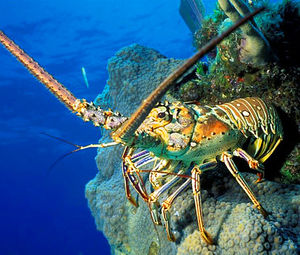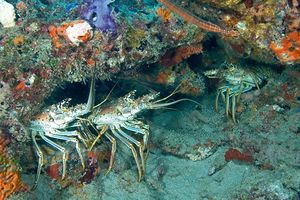SpinyLobster

Caribbean Spiny Lobster (Panulirus argus)
Classification
Kingdom: Animalia
Division: Anthropoda
Class: Malacostraca
Subclass: Florideae
Order: Decapoda
Family: Palinuridae
Genus: Panulirus
Species: P. argus
Anatomy
Belonging to the arthropod phylum P. Argus has a segmented body design, a hard exoskeleton, jointed appendages and is an invertebrate. P. Argus is identifiable by their elongated cylindrical bodies with hard exoskeletons and forward facing spines which lend from the species' common name, Caribbean Spiny Lobster. P. Argus have biramous legs meaning that each leg branches off into two limbs and each branch attaches segments end to end ultimately terminating in a spiked point [1]. Each of the somites on the ventral side of the abdomen is outfitted with swimmerets. These small black and yellow legs are used primarily for swimming, brooding eggs, and catching food and redirecting it toward the mouth and are found on many other arthropods[2]. P. Argus lack large pinching claws found in other species of lobsters; however, they do possess a strong mandible that can crush mollusk shells for feeding[3]. In terms of sexual dimorphism males have a slightly wider sternum than females, unlike their male counterparts female sternums are striated [3].
Range and Habitat

Range
The range of P. argus extends in the North from Cape Hatteras to Bermuda down South towards the Lesser Antilles and ends at the Easternmost tip of Brazil. They also have a heavy presence throughout the Gulf of Mexico and Caribbean Seal.[4]
Habitat
P. Argus are known to be found as in waters up to 100 meters deep as far north as the Outer banks of North Carolina and as far south as the coast of Brazil along the eastern coasts of North and South America. P Argus. can also be found throughout the Gulf of Mexico, the Bahamas, and the Caribbean[5]. Since they are a nocturnal species and the prey of many predators such as Octopi, Sharks, Snappers and Groupers, P. Argus tends to choose a habitat with substantial cover in order to protect itself. This explains why P. Argus is found in and around coral reefs, sea grass beds, beach piers, and under mangrove roots since these habitats allow for a sustainable food source for P. Argus as well as ample protection from predators[3] 4.
Threats
P. argus are declining throughout their range and gone in other regions. They are heavily sought after for their delicious meat and along with the Queen Conch, are one of the most valuable exports of the Caribbean[6]. Due to this, P. Argus is very vulnerable to overfishing by fisheries and recreational sport divers.
To combat this decline, many countries have implemented regulations on the time and place that these lobsters can be caught. Examples of this include Florida's game regulation on P. argus. In Florida, there is a sport season that lasts from the last consecutive Wednesday and Thursday of July each year (27-28 July 2016) as well as a regular season which extends from August 6-March 31 barring catching of P. argus during its breeding season. There is also a catch limit per person that coupled with a minimum size requirement to keep lobster, it allows young P. argus a chance to reach mating age. There are many other regulations in places such as Bermuda and the Caribbean, but unfortunately due to poaching and regulations based on unsatisfactory research the decline of P. argus will more than likely continue to occur eventually placing this species on the threatened species list[7].
Other Names
A study conducted by Shane K. Sarver, et al. studied mtDNA sequences of P. Argus from the Caribbean and the Brazilian coast to determine the genetic diversity in Spiny Lobsters from both locations in order to find whether they were genetically isolated from one another. It was experimentally determined that there was enough DNA sequence diversity to warrant the naming of two subspecies one being Panulirus argus argus which is found north of the equator and in the Caribbean and the other being Panulirus argus westonii which is found south of the equator in Brazil[8]. Other common names for the Caribbean Spiny Lobster include Bermuda spiny lobster, common spiny lobster, Florida spiny lobster, West Indian langouste and West Indian spiny lobster. Most of these names are derived from the location of their habitats and the small changes in coloration and size that correlate with their different environments.
References
- ↑ Gary C. B. Poore (2004). "Glossary". Marine Decapod Crustacea of Southern Australia: a Guide to Identification. CSIRO Publishing. p. 549–556
- ↑ Lipke B. Holthuis (1991). "Panulirus argus". FAO Species Catalogue, Volume 13. Marine Lobsters of the World. FAO Fisheries Synopsis No. 125. Food and Agriculture Organization. pp. 133–134.
- ↑ 3.0 3.1 3.2 Marx, J.M and W.F. Herrnkind. 1986. Species profiles: life histories and environmental requirements for coastal fish and invertebrates (South Florida), spiny lobster. Biol. Rep. 82(11.61).
- ↑ "Caribbean Spiny Lobsters, Panulirus Argus." MarineBio.org. N.p., n.d. Web. 02 Mar. 2016.
- ↑ J. L. Munro (1983). "The biology, ecology and bionomics of spiny lobsters (Palinuridae), apider crabs (Majidae) and other crustacean resources". In J. L. Munro. Caribbean Coral Reef Fishery Resources. ICLARM Technical Reports 7 (2nd ed.). The WorldFish Center. pp. 206–222.
- ↑ "Caribbean Spiny Lobster." Oceana. N.p., n.d. Web. 02 Mar. 2016.
- ↑ Houlihan, Caitlin, and James B. Wood. "Marine Invertebrates of Bermuda Caribbean Spiny Lobster (Panulirus Argus)." Thecephalopodpage. N.p., n.d. Web. 02 Mar. 2016.
- ↑ Sarver, S. K., J. D. Silberman, and P. J. Walsh. 1998. Mitochondrial DNA sequence evidence supporting the recognition of two subspecies or species of the Florida spiny lobster Panulirus argus. J. Crustacean Biology 18(1): 177–186.